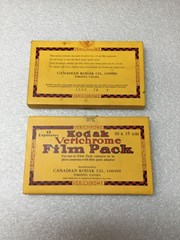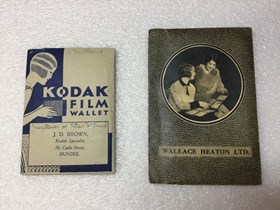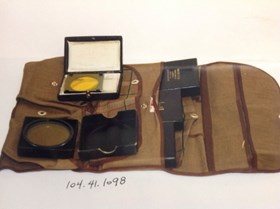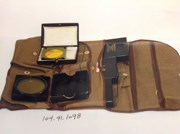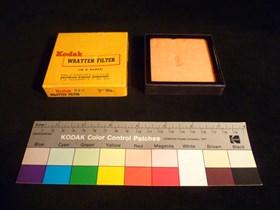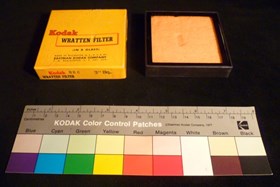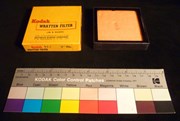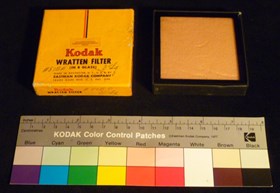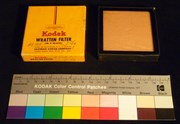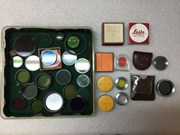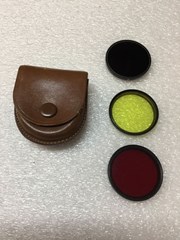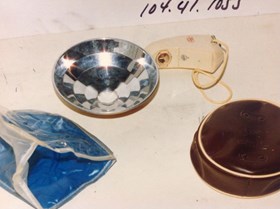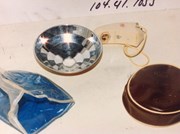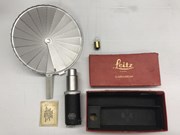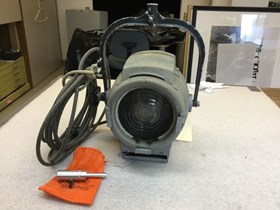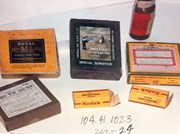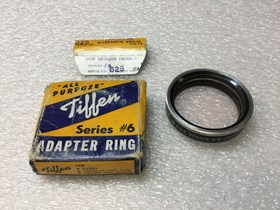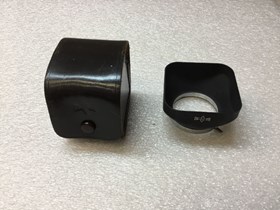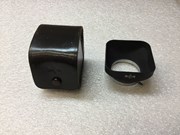Narrow Results By
- Date
- 1930 – 1959
- Material
- leather; metal; fabric; wood
- Catalogue Number
- 104.41.0082 a-c
- Description
- Metal developing tanks dimensions: 13.6x11.6x17.2 or smaller.Torn and crinkled label free-floating inside case reads “DALLON SS TANKS 3 1/4 X 4 1/4 24 CAPACITY.” DALLON most likely refers to David Allan (Dallan) sheet metal workers, specializing in darkroom products, of London England. Case is a ha…
1 image
- Title
- Film Developer
- Date
- 1930 – 1959
- Material
- leather; metal; fabric; wood
- Dimensions
- 16.0 x 17.5 x 30.0 cm
- Description
- Metal developing tanks dimensions: 13.6x11.6x17.2 or smaller.Torn and crinkled label free-floating inside case reads “DALLON SS TANKS 3 1/4 X 4 1/4 24 CAPACITY.” DALLON most likely refers to David Allan (Dallan) sheet metal workers, specializing in darkroom products, of London England. Case is a hard-sided black leather box with a lid that hinges open and held open with a brown leather strip on the left-hand side - also has silver metal clasps and carry handle on the front of the case. The case’s interior is lined with grey fabric and the main compartment is divided into two equal sections that house the metal developing tanks. Nailed to the bottoms of each compartment are pieces of wood to prevent the tanks from sliding around. The metal tanks have lids that lift off - one has notches that could have been used to latch the lid down, but no latches remain, and the other has holes in the middle of the lid from where a handle used to be, the handle is missing. Inside the tanks are cradles with lifting handles at either end and removable curved brackets to mount the film in. One tank has what appears to be a vent with a cap on one end, the cap appears to be stuck in place. Folded-up newspaper packed into empty spaces of case beside the tanks, removed.
- Credit
- Gift of Nicholas Morant, Banff, 2006
- Catalogue Number
- 104.41.0082 a-c
Images
This material is presented as originally created; it may contain outdated cultural descriptions and
potentially offensive content.
Read more.
- Date
- 1938 – 1945
- Material
- cardboard;
- Catalogue Number
- 104.41.0204 a,b
- Description
- Two boxes of 12 10x15cm Kodak Verichrome Film Packs with broken seals. Each box is mostly yellow with black and red manufacturer and product details throughout - there are two paper adhesive stickers holding the box closed, the one that has the expiration date on it on each box is broken.Verichrome…
1 image
- Title
- Film Pack
- Date
- 1938 – 1945
- Material
- cardboard;
- Dimensions
- 1.4 x 17.9 x 10.9 cm
- Description
- Two boxes of 12 10x15cm Kodak Verichrome Film Packs with broken seals. Each box is mostly yellow with black and red manufacturer and product details throughout - there are two paper adhesive stickers holding the box closed, the one that has the expiration date on it on each box is broken.Verichrome was a kind of panchromatic film that yielded high-quality black and white photographs thanks to the fine-grained emulsion. Film Packs were basic forms of storage meant to be used shortly after purchasing as their [mostly] paper packaging did not keep out oxygen well and had a tendency to fog over time, rendering the film unusable in the long term. It was replaced by the more stable Verichrome Pan in the 1950s.
- Credit
- Gift of Robert Crosby Family, Banff, 1998
- Catalogue Number
- 104.41.0204 a,b
Images
This material is presented as originally created; it may contain outdated cultural descriptions and
potentially offensive content.
Read more.
- Date
- 1930 – 1931
- Material
- paper;
- Catalogue Number
- 104.41.0219 a,b
- Description
- Two paper folding envelopes for holding film and/or developed prints - one is Kodak and one is from Wallace Heaton Ltd., a developing studio in London England. Both wallets fold open to show two open-sided pouches where either films or prints could be slotted and have advertising for other services…
1 image
- Title
- Film Wallet
- Date
- 1930 – 1931
- Material
- paper;
- Dimensions
- 0.3 x 11.3 x 16.7 cm
- Description
- Two paper folding envelopes for holding film and/or developed prints - one is Kodak and one is from Wallace Heaton Ltd., a developing studio in London England. Both wallets fold open to show two open-sided pouches where either films or prints could be slotted and have advertising for other services/products printed on them. The Kodak wallet is predominantly white and blue, has a small slip of paper that appears to have “13/5/30 [?] Winton” and several numbers written on it in pencil, several numbers written in pencil on the left-hand side inside, and “Scotland / Negatives of Pete’s Scotland” written in black ink by Catharine Whyte on the front cover. The Wallace Heaton wallet is predominantly grey and black with a picture of two women looking at a photo album on the front cover, a slip of paper that appears to be a receipt for the Browns Hotel made out to “Nice Esq” tucking inside, “Scotland / Nice Esq / egative Scotland 1930” written in different hands on the back [everything except “Nice Esq” written by Catharine Whyte].
- Credit
- Gift of Catharine Robb Whyte, O. C., Banff, 1979
- Catalogue Number
- 104.41.0219 a,b
Images
This material is presented as originally created; it may contain outdated cultural descriptions and
potentially offensive content.
Read more.
- Date
- 1940 – 1960
- Material
- glass; metal; fibre
- Catalogue Number
- 104.41.1098 a-k
- Description
- Five filters - two yellow, one red, one blue, one green, in individual boxes, most marked: “WRATTEN FILTER. EASTMAN KODAK CO. ROCHESTER, N.Y.” in folding khaki canvas case with individual compartments.a) Caseb) Yellow filterc) Boxd) Yellow filtere) Boxf) Red filterg) Boxh) Blue filteri) Boxj) Boxk)…
1 image
- Title
- Filter
- Date
- 1940 – 1960
- Material
- glass; metal; fibre
- Dimensions
- 12.0 x 25.0 cm
- Description
- Five filters - two yellow, one red, one blue, one green, in individual boxes, most marked: “WRATTEN FILTER. EASTMAN KODAK CO. ROCHESTER, N.Y.” in folding khaki canvas case with individual compartments.a) Caseb) Yellow filterc) Boxd) Yellow filtere) Boxf) Red filterg) Boxh) Blue filteri) Boxj) Boxk) Green filterj)
- Subject
- photography
- Vaux family
- Credit
- Gift of Molly Vaux, New York, USA, 1999
- Catalogue Number
- 104.41.1098 a-k
Images
This material is presented as originally created; it may contain outdated cultural descriptions and
potentially offensive content.
Read more.
- Date
- 1940 – 1960
- Material
- glass; paper
- Catalogue Number
- 104.41.1128 a-c
- Description
- Kodak 3-inch square filter with original box. (a) The original box consists of a top (lid) and a bottom. The top of the yellow coloured box is square and measures 8.2cm x 8.2cm, which is slightly larger than the 3-inch filter allowing the box to safely store the object. On the face of the lid “Koda…
1 image
- Title
- Filter
- Date
- 1940 – 1960
- Material
- glass; paper
- Dimensions
- (a) 1.9; (b) 1.7; (c) 0.425 x (a) 8.3; (b) 8.0; (c) 7.6 x (a) 8.3; (b) 8.0; (c) 7.6 cm
- Description
- Kodak 3-inch square filter with original box. (a) The original box consists of a top (lid) and a bottom. The top of the yellow coloured box is square and measures 8.2cm x 8.2cm, which is slightly larger than the 3-inch filter allowing the box to safely store the object. On the face of the lid “Kodak” has been written inside of a red coloured box, which is attached to a black coloured box with the word “filter” written inside. Below this “3-INCH SQUARE” has been (machine) printed in black lettering. Along the viewer left and right sides of the box a half circular cutout is present to allow for easier removal of the box’s lid. Much like the face of the box lid, the front side of the box also has the company name “Kodak” written inside of the red coloured box, which is attached to a black coloured box with the word “filter” printed inside. Next to the company and product names “3-INCH SQUARE” is (machine) printed in black lettering. Below this an ink stamp has been applied, possibly by Nick himself, and reads: “N.D.03.” This stamp has been smudged slightly distorting the mark, although it is still legible. This code symbolizes the colour of the filter, which is a deep neutral slightly warm grey colour that has a neutral density to reduce very bright sunlight, which has a fine mark from bonding agent breakdown. The back of the lid has all of the manufacturer information in red which reads: “EASTMAN KODAK COMPANY” “MADE IN ROCHESTER N.Y. U.S.A. T.M. REGISTERED U.S. PAT. OFF.” On the inside of the lid, on the same side as the manufacturer information, “Code No. 4767” “KP 51378” “printed in U.S.A.” has been (machine) printed. When looking at the inside of the lid it becomes apparent that the information on the boxes lid would have been printed as a whole on the glossy-style paper before being adhered to the cardboard lid. (b)The bottom of the filter’s case is made from plain black cardboard that contains no writing. The inside of the box’s bottom does have a cushioned material that would have supported the object and eliminated any concerns of scratching. (c) The Kodak filter would have been used for printing onto UV sensitive papers. The glass filter absorbs light and only transmits the UV radiation to sharpen prints. The filter measures approximately 7.6cm or 3-inches. Around the edges of the clear glass is a black border. At the top of the border the words: “DEN. 0.30” has been painted in gold, which represents the colour code of the filter. Along the bottom of the border the letter “V” has been painted in gold. This information has also been written on the reverse of the object.
- Subject
- photography
- Nick Morant
- Credit
- Gift of Nicholas Morant, Banff, 2006
- Catalogue Number
- 104.41.1128 a-c
Images
This material is presented as originally created; it may contain outdated cultural descriptions and
potentially offensive content.
Read more.
- Date
- 1940 – 1960
- Material
- glass; paper; ink
- Catalogue Number
- 104.41.1129 a-c
- Description
- Kodak 3-inch square Wratten filter with original box.(a) The original box consists of a top (lid) and a bottom. The top of the yellow coloured box is square and measures 8.2cm x 8.2cm, which is slightly larger than the 3-inch filter allowing the box to safely store the object. The face of the lid c…
1 image
- Title
- Filter
- Date
- 1940 – 1960
- Material
- glass; paper; ink
- Dimensions
- (a) 1.9; (b) 1.7; (c) 0.425 x (a) 8.3; (b) 8.0; (c) 7.6 x (a) 8.3; (b) 8.0; (c) 7.6 cm
- Description
- Kodak 3-inch square Wratten filter with original box.(a) The original box consists of a top (lid) and a bottom. The top of the yellow coloured box is square and measures 8.2cm x 8.2cm, which is slightly larger than the 3-inch filter allowing the box to safely store the object. The face of the lid contains the following words: “Kodak” “WRATTEN FILTER” “(IN B GLASS)” which has been (machine) printed. Below this the manufacturer information has been printed and reads: “MADE IN ROCHESTER, N.Y., U.S.A. BY” “EASTMAN KODAK COMPANY” “T.M. REGISTERED U.S. PAT. OFF.” Along the viewer left and rights side of the box a half circular cutout is present to allow for easier removal of the box’s lid. Both the front and back of the box has the company name, “Kodak” “WRATTEN FILTER” (machine) printed. An ink stamp has been hand applied, possibly by Nick Morant himself, to both the front and back of the box`s edges and reads: “85C” “3** Sq.” “Code 4417” “KP 34344B” “Printed in U.S.A.” in black letters. The code 85C represents the colour code, which would have been a light orange and would have helped correct bluish casts that often occur when photographing outdoors. The 85C series filter would have decreased the colour temperature from 5500-3800 degrees Kelvin. When looking at the inside of the lid it becomes apparent that the original material used for the structural security of the box would have been covered in a paper that would have had the information, specified above, printed on glossy-style paper before meticulously being adhered to the lid. Also on the inside of the lid in blue pen “85-C Daylite Filter for Type F Kodachrome on Ektachrome Type F`s.” has been written, possibly by Nicholas Morant. (b) The bottom of the box has the plain white cardboard with a black covering that contains no writing. The inside of the box’s bottom no longer has the original cushioned material that would have supported the object. Several folded and layered pieces of cotton-style tissue have been neatly ordered to prevent scratching to the objects’ surface. (c) The Kodak filter would have been used for printing onto UV sensitive papers. The glass filter absorbs light and only transmits the UV radiation to sharpen prints. The filter measures approximately 7.6 cm or 3 inches. Around the edges of the clear glass is a black border. At the top of the border the words: “FILTER NO. 85C” has been painted in gold. Along the viewer left side of the object there is also three straight lines in gold. Both of these patterns are mirrored on the reverse of the filter.
- Subject
- photography
- Nick Morant
- Credit
- Gift of Nicholas Morant, Banff, 2006
- Catalogue Number
- 104.41.1129 a-c
Images
This material is presented as originally created; it may contain outdated cultural descriptions and
potentially offensive content.
Read more.
- Date
- 1940 – 1960
- Material
- glass; paper; ink
- Catalogue Number
- 104.41.1130 a-c
- Description
- Kodak 3-inch square Wratten filter with original box.(a) The original box consists of a top (lid) and a bottom. The top of the yellow coloured box is square and measures 8.2 cm x 8.2 cm, which is slightly larger than the 3-inch filter allowing the box to safely store the object. The face of the lid…
1 image
- Title
- Filter
- Date
- 1940 – 1960
- Material
- glass; paper; ink
- Dimensions
- (a) 1.9; (b) 1.7; (c) 0.425 x (a) 8.3; (b) 8.0; (c) 7.6 x (a) 8.3; (b) 8.0; (c) 7.6 cm
- Description
- Kodak 3-inch square Wratten filter with original box.(a) The original box consists of a top (lid) and a bottom. The top of the yellow coloured box is square and measures 8.2 cm x 8.2 cm, which is slightly larger than the 3-inch filter allowing the box to safely store the object. The face of the lid contains the following words: “Kodak” “WRATTEN FILTER” “(IN B GLASS)” which has been printed. Above the company logo a yellow sticker has been adhered and reads: “SOLE IMPORTER INTO CANADA” “CANADIAN KODAK CO., LIMITED” “TORONTO” in blue letters. Handwritten in blue pen on the viewer right side of “(IN B GLASS)” the filter colour code “#81EF” has been written; on the viewer right side of the same part “31”Sq” has been written. Below this the manufacturer information has been printed and reads: “MADE IN ROCHESTER, N.Y., U.S.A. BY” “EASTMAN KODAK COMPANY” “T.M. REGISTERED U.S. PAT. OFF.” Along the viewer left and rights side of the box a half circular cut-out is present to allow for easier removal of the box’s lid. The front of the box has the company name, “Kodak” “WRATTEN FILTER” printed. Handwritten in blue pen “#81EF” and “31”Sq” have been applied to the box. The code 81EF represents the colour code, which would have been a light balancing yellow and would have enabled minor adjustments in the colour quality of illumination to obtain cooler bluish or warmer yellowish colour rendering. When looking at the inside of the lid it becomes apparent that the original material used for the structural security of the box would have been covered in a paper that would have had the information, specified above, printed on glossy-style paper before meticulously being adhered to the lid. Also on the inside of the lid, in what has been referred previously as the back of the box, the Kodak company has printed “CODE 4417” “KP 34344A.” (b) The bottom of the box has the plain paper material with a black covering that contains no writing. The inside of the box’s bottom have a cushioned material that supports the object eliminating the possibility of scratching. (c) The Kodak filter would have been used for printing onto UV sensitive papers. The glass filter absorbs light and only transmits the UV radiation to sharpen prints. The filter measures approximately 7.6 cm or 3 inches. Around the edges of the clear glass is a black border. At the top of the border the words: “FILTER NO. 81EF” has been painted in gold. Along the viewer left side of the object there is another figure possibly an “I” or “1”also in gold, but is difficult to make out with any degree of certainty. Both of these patterns are mirrored on the reverse of the filter.
- Subject
- photography
- Nick Morant
- Credit
- Gift of Nicholas Morant, Banff, 2006
- Catalogue Number
- 104.41.1130 a-c
Images
This material is presented as originally created; it may contain outdated cultural descriptions and
potentially offensive content.
Read more.
- Date
- 1930 – 1970
- Material
- plastic; fabric; felt; leather; glass; cardboard;
- Catalogue Number
- 104.41.0212
- Description
- Square clear plastic box lined with green felt containing 26 camera filters and 2 lens caps - 6 filters are in various containers, one is unopened. Most filters were manufactured by Leitz Wetzler [the company changed its name to Leica in 1986], some are Kodak, and two are Zeiss. Filters include yel…
1 image
- Title
- Filter Box
- Date
- 1930 – 1970
- Material
- plastic; fabric; felt; leather; glass; cardboard;
- Dimensions
- 3.8 x 23.2 x 23.2 cm
- Description
- Square clear plastic box lined with green felt containing 26 camera filters and 2 lens caps - 6 filters are in various containers, one is unopened. Most filters were manufactured by Leitz Wetzler [the company changed its name to Leica in 1986], some are Kodak, and two are Zeiss. Filters include yellow, orange, red, blue, tinted, and clear patterned glass.
- Credit
- Gift of Catharine Robb Whyte, O. C., Banff, 1979
- Catalogue Number
- 104.41.0212
Images
This material is presented as originally created; it may contain outdated cultural descriptions and
potentially offensive content.
Read more.
- Date
- 1930 – 1970
- Material
- metal; glass; leather;
- Catalogue Number
- 104.41.0216
- Description
- Three colour tinted Leica lens filters in a snap-closed leather pouch - one filter is red, one yellow, one very dark red [looks black without a light behind it].
1 image
- Title
- Filter Lens
- Date
- 1930 – 1970
- Material
- metal; glass; leather;
- Dimensions
- 2.4 x 5.8 x 6.6 cm
- Description
- Three colour tinted Leica lens filters in a snap-closed leather pouch - one filter is red, one yellow, one very dark red [looks black without a light behind it].
- Credit
- Gift of Catharine Robb Whyte, O. C., Banff, 1979
- Catalogue Number
- 104.41.0216
Images
This material is presented as originally created; it may contain outdated cultural descriptions and
potentially offensive content.
Read more.
Flash Attachment
https://archives.whyte.org/en/permalink/artifact104.41.1055%20a-d
- Date
- 1940 – 1960
- Material
- plastic, metal, leather
- Catalogue Number
- 104.41.1055 a-d
- Description
- Flash (a) with case (b), rain hood (c); reflector (d), white coloured "Ikoblitz" embossed on the side; sync cord on one side; red button at top to release bulb; green at back for testing; reflector detaches;thin plastic hood with 3 sides: blue, clear, frosted (to prevent bulb shattering damage); b…
1 image
- Title
- Flash Attachment
- Date
- 1940 – 1960
- Material
- plastic, metal, leather
- Description
- Flash (a) with case (b), rain hood (c); reflector (d), white coloured "Ikoblitz" embossed on the side; sync cord on one side; red button at top to release bulb; green at back for testing; reflector detaches;thin plastic hood with 3 sides: blue, clear, frosted (to prevent bulb shattering damage); brown case with white trim, zipper close.
- Subject
- photography
- Credit
- Gift of Robert N. Smith, Canmore, 1985
- Catalogue Number
- 104.41.1055 a-d
Images
This material is presented as originally created; it may contain outdated cultural descriptions and
potentially offensive content.
Read more.
- Date
- 1940 – 1960
- Material
- Metal; plastic; cardboard; glass;
- Catalogue Number
- 104.41.1206 a-f
- Description
- LEICA GAVOO Synchronizer rangefinder Leitz camera flash system dish box cableA: Retractable flash disk. B: Stand for Camera and flash disk.C: Small light bulb with gold base. Filament appears to be functional. D: Black cord with large black end and smaller silver end. The larger black end has red d…
1 image
- Title
- Flash Camera
- Date
- 1940 – 1960
- Material
- Metal; plastic; cardboard; glass;
- Dimensions
- 6 x 8 x 17 cm
- Description
- LEICA GAVOO Synchronizer rangefinder Leitz camera flash system dish box cableA: Retractable flash disk. B: Stand for Camera and flash disk.C: Small light bulb with gold base. Filament appears to be functional. D: Black cord with large black end and smaller silver end. The larger black end has red dots in two corners and looks like it comes apart in two. the silver end has the same logo that items A and B have “E.LEITZ; WETZLAR; GERMANY” E: light brown tissue package with 2 metal bits of hardware inside. Outside of package reads: “Schraubenzieher zur Befestigung des Metraphot-fufses (Siehe Gebrauchsanweisung erhohter fufs) wenn not wendig. The opposite side says: Screwdriver to fix the metraphot-footplate (see our directions for use page 8...10) Elevated Foot to change if needed. F: Red Box, lid detached. Top of lid reads: Leitz ; Germany; Synchronblitzer in gold script. the bottom of the box has blue ink stamp: Ceyoo Feet
- Credit
- Gift of Harold C. Whyte, Penticton, 2017
- Catalogue Number
- 104.41.1206 a-f
Images
This material is presented as originally created; it may contain outdated cultural descriptions and
potentially offensive content.
Read more.
- Date
- 1940 – 1960
- Material
- metal; glass; plastic; fabric;
- Catalogue Number
- 102.05.0115
- Description
- Dull grey metal flood/spotlight used in studio settings for film-making or photography. The main body of the light is shaped like a small barrel - one end has a carved crystal bordered in thick cord and the other has a door that opens by pushing a small button in order to access the light bulb insi…
1 image
- Title
- Flood Light
- Date
- 1940 – 1960
- Material
- metal; glass; plastic; fabric;
- Dimensions
- 42.0 x 28.0 x 31.0 cm
- Description
- Dull grey metal flood/spotlight used in studio settings for film-making or photography. The main body of the light is shaped like a small barrel - one end has a carved crystal bordered in thick cord and the other has a door that opens by pushing a small button in order to access the light bulb inside. The centre of the door features the Bardwell & McAlister Inc. logo. The barrel also has housing attached to the top and bottom - one contains a lever that, when pushed from side to side, moves the light bulb inside closer to or further from the crystal. Attached to the front on either side of the crystal are brackets where a filter can be fit; a Y-shaped support can be rotated 180 degrees and is adjusted by a handle on one side; an on/off switch sits in a raised metal bracket on one side, and near the switch the power cord feeds out of the barrel - the cord is wrapped in grey fabric and is coiled up and attached to the support with a short length of rope. Attached to the power cord is an orange fabric bag with a wire drawstring that contains a silver metal cylinder that could possibly be an attachment for the support.
- Credit
- Gift of Nicholas Morant, Banff, 2006
- Catalogue Number
- 102.05.0115
Images
This material is presented as originally created; it may contain outdated cultural descriptions and
potentially offensive content.
Read more.
- Date
- 1940 – 1960
- Material
- metal; glass; plastic;
- Catalogue Number
- 102.05.0116
- Description
- Dull grey metal flood/spotlight used in studio settings for film-making or photography. The main body of the light is shaped like a small barrel - one end has a carved crystal bordered in thick cord and the other has a door that opens by pushing a small button in order to access the light bulb insi…
1 image
- Title
- Flood Light
- Date
- 1940 – 1960
- Material
- metal; glass; plastic;
- Dimensions
- 42.0 x 28.0 x 31.0 cm
- Description
- Dull grey metal flood/spotlight used in studio settings for film-making or photography. The main body of the light is shaped like a small barrel - one end has a carved crystal bordered in thick cord and the other has a door that opens by pushing a small button in order to access the light bulb inside. The centre of the door features the Bardwell & McAlister Inc. logo. The barrel also has housing attached to the top and bottom - one contains a lever that, when pushed from side to side, moves the light bulb inside closer to or further from the crystal. Attached to the front on either side of the crystal are brackets where a filter can be fit; a Y-shaped support can be rotated 180 degrees and is adjusted by a handle on one side; an on/off switch sits in a raised metal bracket on one side, and near the switch the black plastic power cord feeds out of the barrel - the cord is coiled up and attached to the support with a short length of rope.
- Credit
- Gift of Nicholas Morant, Banff, 2006
- Catalogue Number
- 102.05.0116
Images
This material is presented as originally created; it may contain outdated cultural descriptions and
potentially offensive content.
Read more.
Folding Camera
https://archives.whyte.org/en/permalink/artifact104.41.0250
- Date
- c. 1947
- Material
- metal; plastic; glass; leather;
- Catalogue Number
- 104.41.0250
- Description
- A black and silver folding Graflex Crown Graphic camera. The exterior of the camera, on either short side features a silver mount for flashes and shutter release button, which is a rectangle button, (left side) and black leather strap handle (right side). On the back of the camera is a section for …
1 image
- Title
- Folding Camera
- Date
- c. 1947
- Material
- metal; plastic; glass; leather;
- Dimensions
- 21.4 x 19.0 x 10.0 cm
- Description
- A black and silver folding Graflex Crown Graphic camera. The exterior of the camera, on either short side features a silver mount for flashes and shutter release button, which is a rectangle button, (left side) and black leather strap handle (right side). On the back of the camera is a section for the cut film, released by two metal latches, as well as a ground glass back hidden under the folding viewfinder [letting the user know exactly how the image will appear on the film] and releases with a small metal clasp. Towards the top of the back is a metal arm with a black plastic circle at the top that can be slid up as a circular peep finder with various focal ranges on it. On the top of the camera is two other view finders mounted, which are positioned on the right side of the camera, on the left side is a red button. In front of the mount is a raised button (covered in the leather finish) near the the smaller viewfinder, this triggers the camera to open revealing the camera lens. When open the lens is mounted on rails that slides forward and back with soft black leather bellows. It is moved forward by twisting a metal arm with a circle on top in the middle of the lens, this also locks the lens into place on the track. There are two different sets of knobs on either of the lens which allow the lens to lift up and tilt, and with a metal arm at the front of the lens to use for these movements. The metal knobs on the front panel move the inner track that the lens is attached to to move forward and backwards. Along this track is a focal range meter (right side). The front of the camera lens mount reads “Crown [in cursive] GRAPHIC”. The actual lens is missing.
- Subject
- film photography
- photography
- Graflex
- Harmon
- camera
- Credit
- Gift of Don Harmon, Banff, 1985
- Catalogue Number
- 104.41.0250
Images
This material is presented as originally created; it may contain outdated cultural descriptions and
potentially offensive content.
Read more.
Grafmatic Film Holder
https://archives.whyte.org/en/permalink/artifact104.41.1272%20a-c
- Date
- 1946 – 1968
- Material
- metal; plastic;
- Catalogue Number
- 104.41.1272 a-c
- Description
- 4” x 5” Grafmatic film back or film holder that consists of a black metallic case holding 6 sheets of film placed in septums; one long side shut by a dark slide can be removed to expose the film; on the dark slide handle side, there is a twisting dented wheel that is a locking mechanism and a silve…
1 image
- Title
- Grafmatic Film Holder
- Date
- 1946 – 1968
- Material
- metal; plastic;
- Dimensions
- 12.0 x 21.8 cm
- Description
- 4” x 5” Grafmatic film back or film holder that consists of a black metallic case holding 6 sheets of film placed in septums; one long side shut by a dark slide can be removed to expose the film; on the dark slide handle side, there is a twisting dented wheel that is a locking mechanism and a silver knob to operate the unit; a) on the long sealed side, printed in white are the manufacturer’s details and logo: “Grafmatic ® FILM HOLDER / CAT. NO. 1268 / “45” GRAP”; the rest of the word is hidden under a white sticker with the number 11 printed in black: “GRAFLEX INC., ROCHESTER, N.Y. MADE IN” and the rest of the line is again obstructed by the sticker; a second white sticker presents in red ink the operating instructions, partially smudged, with accretion; a third white sticker reads in black pen handwriting: “V-3 ASA 160”; green ribbon tied to the handleb) on the long sealed side, printed in white are the manufacturer’s details and logo: “CAT. NO. 1268 GRAPHIC / GRAFLEX / GENERAL PRECISION / Grafmatic FILM HOLDER / GRAFLEX, INC./ A SUBSIDIARY OF GENERAL PRECISION EQUIPMENT CORP.”; a white sticker bears the care instructions printed in red: “PREVENT DAMAGE TO SEPTUMS WHEN LOADING / 1. Push counter slide back into end of drawer. / 2. Replace septums with notch opposite slide handle. / 3. Close slide completely, then close drawer. / 4. Pull slide all the way out--then return--always complete the cycle.”; a second white sticker bears in black pen handwriting: “V-3 ASA-160”; a third white sticker displays the number “7” printed in red; green ribbon tied to the handlec) Grafmatic back slide stored in a yellow envelope labelled “GRAFAMATIC” (sic) handwritten vertically in black pen along a wavy line
- Subject
- Nicholas Morant
- photography
- Credit
- Gift of Nicholas Morant, Banff, 2006
- Catalogue Number
- 104.41.1272 a-c
Images
This material is presented as originally created; it may contain outdated cultural descriptions and
potentially offensive content.
Read more.
Lantern Slide Accessories
https://archives.whyte.org/en/permalink/artifact104.41.1023%20a-g
- Date
- 1940 – 1950
- Material
- paper, glass
- Catalogue Number
- 104.41.1023 a-g
- Description
- Lantern slide supplies, roll film, film cement; (a) grey paper box (11.1x2.6x9.1) for holding lantern plates; label:Imperial "Velona" Lantern Plates, with directions for use; (b) orange paper box (11.3x2.2x9.3) for holding lantern slide plates; label "Royal Lantern SlidePlate, Canadian Kodak Co."; …
1 image
- Title
- Lantern Slide Accessories
- Date
- 1940 – 1950
- Material
- paper, glass
- Description
- Lantern slide supplies, roll film, film cement; (a) grey paper box (11.1x2.6x9.1) for holding lantern plates; label:Imperial "Velona" Lantern Plates, with directions for use; (b) orange paper box (11.3x2.2x9.3) for holding lantern slide plates; label "Royal Lantern SlidePlate, Canadian Kodak Co."; writing on box lid; (c) unopened box with greypaper wrapping (9.2 x2.1x12.3); label on front "Imperial Orthochrome Plates; special sensitive Imperial Dry Plate Co Ltd. with illustration of boy in sailor suit photographing girl and small child on rocks by seaside; back label listing material quality; (d) 16 mm motion picture film box; stickers w/B.Harmon; Harmony Drug Store Ltd.. (9.8x2.7x9.7); (e,f) 2 roll film each box (6.3x2.3x2.3)\ labelled "Kodak Verichrome film; (g) glass bottle (empty) film cement, cork in top with tape wrapped total height around label: A.S.N. withuse mentioned; (bottle: 10.2 x 4.0 dia.).
- Subject
- photography
- Credit
- Gift of Pearl Evelyn Moore, Banff, 1977
- Catalogue Number
- 104.41.1023 a-g
Images
This material is presented as originally created; it may contain outdated cultural descriptions and
potentially offensive content.
Read more.
Lantern Slide Box
https://archives.whyte.org/en/permalink/artifact104.41.1315%20a-c
- Date
- 1931
- Material
- wood; varnish; metal; paper; felt; plastic
- Catalogue Number
- 104.41.1315 a-c
- Description
- three lantern slide boxes:(a) rectangular wooden box with lid hinged on one long side and two hooks on the opposite side; Dark brown varnish coating; rabbet joinery; on one of the box small sides, there is a Dymo label with archival number: “V353 / PS 1 - 78” above a yellowed label with red frame w…
1 image
- Title
- Lantern Slide Box
- Date
- 1931
- Material
- wood; varnish; metal; paper; felt; plastic
- Dimensions
- (a) 12.0 ; (b) 12.5 ; (c) 14.4 x (a) 12.2 ; (b) 12.2 ; (c) 12.7 x (a) 32.0; (b) 32.7; (c) 33.0 cm
- Description
- three lantern slide boxes:(a) rectangular wooden box with lid hinged on one long side and two hooks on the opposite side; Dark brown varnish coating; rabbet joinery; on one of the box small sides, there is a Dymo label with archival number: “V353 / PS 1 - 78” above a yellowed label with red frame with number 19 in top left corner, circled in green and print: “LEACOCK SLIDES / 1925 - 1931 / 1 - 78”; black pen handwritten number “191” in top left corner of small side; three square compartments inside with sides padded with green felt(b) similarly built box to (a) with smaller dimensions ; Dymo label on one small side with archival number: “V353 / PS 79 - 156”; Black pen handwriting on the lid’s side: “191 LEACOCK / 79 - 156”; number 191 circled in green(c) rectangular wooden box with lid hinged on one long side and two hooks on the opposite side; dark brown varnish coating; dovetail joinery; on one of the box small sides, there is a Dymo label with archival number: “V353 / PS 157 - 234” above a yellowed label with red frame and number 19 in top left corner, circled in green and print: “LEACOCK SLIDES / 1925 - 1931 / 157 - 234”; three square compartments inside with sides padded with Bordeaux felt
- Credit
- Gift of Glenbow Archives, Calgary, 1995
- Catalogue Number
- 104.41.1315 a-c
Images
This material is presented as originally created; it may contain outdated cultural descriptions and
potentially offensive content.
Read more.
- Date
- 1935 – 1980
- Material
- metal; leather; plastic; glass; paper
- Catalogue Number
- 104.41.0089 a-s
- Description
- Leica G (Leica IIIa) black and silver camera in a brown leather case and various lenses, filters, triggers, film canister, and plastic envelope folder filled with various instruction manuals. The camera is fitted with a Leitz Elmar f=3,5cm lens with a black plastic lens cap. Also includes a “P. Ang…
1 image
- Title
- Leica Camera
- Date
- 1935 – 1980
- Material
- metal; leather; plastic; glass; paper
- Dimensions
- 8.7 x 6.7 x 14.3 cm
- Description
- Leica G (Leica IIIa) black and silver camera in a brown leather case and various lenses, filters, triggers, film canister, and plastic envelope folder filled with various instruction manuals. The camera is fitted with a Leitz Elmar f=3,5cm lens with a black plastic lens cap. Also includes a “P. Angenieux F. 90 1 : 2,5” zoom lens housed in what appears to be a homemade fabric sleeve, Leica viewfinder in a brown leather case, and three other empty lenses that house various lenses in either brown leather cases and a red fabric bag, possibly homemade.Filters include a yellow metal-mounted “KODAK SERIES VI ADAPTER RING” in a red fabric bag, metal-mounted “Series VI Kodak Pola-Screen” in a yellow Kodak cardboard box, a blue “80 - B Floods with Daylight Film” filter in a black and clear plastic box, two “Kodak Series VI color compensation” metal-ringed filters in a black and yellow “KODAK” plastic case, and three warm-toned “KODAK TYPE A COLOR FILMS” filters in individual clear plastic cases.Other accessories include extended triggers (used to minimize camera movement when taking a picture), brackets and braces for attaching the camera to a tripod, and two empty cases - one a black Leica case probably for a lens and the other a white film canister.
- Credit
- Gift of Nicholas Morant, Banff, 2006
- Catalogue Number
- 104.41.0089 a-s
Images
This material is presented as originally created; it may contain outdated cultural descriptions and
potentially offensive content.
Read more.
- Date
- 1938 – 1960
- Material
- cardboard; metal; glass;
- Catalogue Number
- 104.41.0199
- Description
- Black and silver metal Tiffen Series #6 adapter ring in the original blue and orange cardboard box.
1 image
- Title
- Lens Filter
- Date
- 1938 – 1960
- Material
- cardboard; metal; glass;
- Dimensions
- 1.6 x 5.8 x 5.3 cm
- Description
- Black and silver metal Tiffen Series #6 adapter ring in the original blue and orange cardboard box.
- Credit
- Gift of Robert Crosby Family, Banff, 1998
- Catalogue Number
- 104.41.0199
Images
This material is presented as originally created; it may contain outdated cultural descriptions and
potentially offensive content.
Read more.
- Date
- 1940 – 1960
- Material
- metal; leather
- Catalogue Number
- 104.41.0142
- Description
- Black and silver metal Mamiya-Sekor twin flex lens hood in a brown leather case that snaps closed. Both the lens hood and case have the logo embossed on one side and “MADE IN JAPAN” on the other.
1 image
- Title
- Lens Hood
- Date
- 1940 – 1960
- Material
- metal; leather
- Dimensions
- 6.8 x 5.2 x 7.3 cm
- Description
- Black and silver metal Mamiya-Sekor twin flex lens hood in a brown leather case that snaps closed. Both the lens hood and case have the logo embossed on one side and “MADE IN JAPAN” on the other.
- Credit
- Gift of Nicholas Morant, Banff, 2006
- Catalogue Number
- 104.41.0142
Images
This material is presented as originally created; it may contain outdated cultural descriptions and
potentially offensive content.
Read more.




